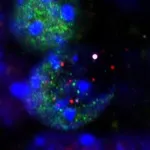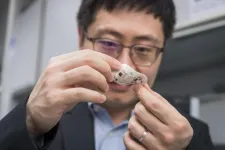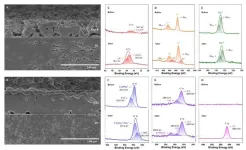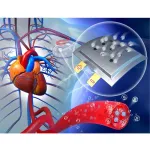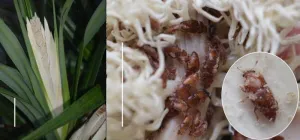New topological metamaterial amplifies sound waves exponentially
2024-03-27
(Press-News.org) Researchers at AMOLF, in collaboration with partners from Germany, Switzerland, and Austria, have realized a new type of metamaterial through which sound waves flow in an unprecedented fashion. It provides a novel form of amplification of mechanical vibrations, which has the potential to improve sensor technology and information processing devices. This metamaterial is the first instance of a so-called ‘bosonic Kitaev chain’, which gets its special properties from its nature as a topological material. It was realized by making nanomechanical resonators interact with laser light through radiation pressure forces. The discovery, which is published on March 27 in the renowned scientific journal Nature, was achieved in an international collaboration between AMOLF, the Max Planck Institute for the Science of Light, the University of Basel, ETH Zurich, and the University of Vienna.
The ‘Kitaev chain’ is a theoretical model that describes the physics of electrons in a superconducting material, specifically a nanowire. The model is famous for predicting the existence of special excitations at the ends of such a nanowire: Majorana zero modes. These have gained intense interest because of their possible use in quantum computers. AMOLF group leader Ewold Verhagen: “we were interested in a model that looks mathematically identical, but describes waves like light or sound, instead of electrons. Since such waves consist of bosons (photons or phonons) rather than fermions (electrons), their behavior is expected to be very different. Nonetheless, in 2018 it was predicted that a bosonic Kitaev chain exhibits fascinating behavior that is not known of any natural material, nor of any metamaterial to date. While many scientists were interested, experimental realization remained elusive.”
Optical springs
The bosonic Kitaev chain is essentially a chain of coupled resonators. It is a metamaterial, i.e., a synthetic material with engineered properties: the resonators can be thought of as the ‘atoms’ of a material, and the way they are coupled together controls the collective metamaterial behavior; in this case the propagation of sound waves along the chain. “The couplings – the links of the bosonic Kitaev chain – need to be special, and can’t be made with regular springs, for example,” says first author of the Nature paper Jesse Slim, who graduated cum laude last year. “We realized that we could experimentally create the required links between nanomechanical resonators – small vibrating silicon strings on a chip – by coupling them with the help of forces exerted by light; thus creating ‘optical’ springs. Carefully varying the intensity of a laser over time then allowed linking five resonators and implementing the bosonic Kitaev chain.”
Exponential amplification
The result was striking. “The optical coupling mathematically resembles the superconducting links in the fermionic Kitaev chain,” says Verhagen. “But uncharged bosons do not exhibit superconductivity; instead, optical coupling adds amplification to the nanomechanical vibrations. As a result, sound waves, which are the mechanical vibrations propagating through the array, are exponentially amplified from one end to the other. Interestingly, in the opposite direction transmission of vibrations is forbidden. And even more intriguing, if the wave is delayed a bit – by a quarter of an oscillation period – the behavior is completely inverted: the signal is amplified backwards and blocked forwards. The bosonic Kitaev chain thus acts like a unique type of directional amplifier, which could have interesting applications for signal manipulation, in particular in quantum technology.”
Topological metamaterial
The interesting properties of Majorana zero modes in the electronic Kitaev chain are linked to the fact that the material is topological. In topological materials, certain phenomena are invariably connected to the general mathematical description of the material. Those phenomena are then topologically protected, meaning that they are guaranteed to exist, even if the material suffers from defects and perturbations. The understanding of topological materials was awarded the Nobel prize of physics in 2016, but this encompassed only materials that do not feature amplification or damping. The description of topological phases that do include amplification is still a topic of intense research and debate. Together with theory collaborators Clara Wanjura (Max Planck Institute for the Science of Light), Matteo Brunelli (University of Basel), Javier del Pino (ETH Zurich), and Andreas Nunnenkamp (University of Vienna), the AMOLF researchers showed that the bosonic Kitaev chain is in fact a new topological phase of matter. The observed directional amplification is a topological phenomenon associated with this phase of matter, as the theory collaborators predicted in 2018. They demonstrated a unique experimental signature of the topological nature of the metamaterial: if the chain is closed, such that it forms a ‘necklace’, amplified sound waves in the ring of resonators keep circulating and reach a very high intensity, similar to how strong light beams are generated in lasers.
Boosting sensor performance?
Verhagen: “Because of topological protection, the amplification is in principle insensitive to disturbances. But interestingly, the chain is in fact extra sensitive to one particular type of disturbance; if the frequency of the last resonator on the chain is slightly perturbed, the amplified signals along the chain can suddenly travel backwards again, experiencing amplification a second time. The result is that the system is very sensitive to such a small perturbation, which could be caused by the mass of a molecule adhering to the resonator or a qubit interacting with it.”
With the ERC Consolidator Grant that he recently acquired, Verhagen wants to investigate the possibilities to enhance sensitivity of nanomechanical sensors in these systems. “We have seen the first indications of the sensing capabilities in our experiments, which is very exciting. We now need to investigate in more detail how these topological sensors work, whether the sensitivity is boosted in the presence of various types of noise sources, and which interesting sensor technologies can benefit from these principles. This is just the beginning of that endeavor.”
END
ELSE PRESS RELEASES FROM THIS DATE:
2024-03-27
March 27, 2024—(BRONX, NY)—Just as you can’t make an omelet without breaking eggs, scientists at Albert Einstein College of Medicine have found that you can’t make long-term memories without DNA damage and brain inflammation. Their surprising findings were published online today in the journal Nature.
“Inflammation of brain neurons is usually considered to be a bad thing, since it can lead to neurological problems such as Alzheimer’s and Parkinson’s disease,” said study leader Jelena Radulovic, M.D., Ph.D., professor in the Dominick P. Purpura Department of Neuroscience, professor of psychiatry and behavioral sciences, and the Sylvia ...
2024-03-27
Anastasopoulos Studying Machine Translation For Austronesian Languages
Antonios Anastasopoulos, Assistant Professor, Computer Science, received funding for: "Machine Translation for Austronesian Languages."
He is helping to develop a solution that can automatically translate languages of the southeast Asia and Pacific regions, with a particular focus on languages of lndonesia and the Philippines.
Anastasopoulos received $63,680 from Barron Associates, Inc., on a subaward from the U.S. Department of the Army for this project. Funding began ...
2024-03-27
The first comprehensive reference genome for ‘R570’, a widely cultivated modern sugarcane hybrid, has been completed in a landmark advancement for agricultural biotechnology.
Sugarcane contributes $2.2 billion to the Australian economy and accounts for 80 per cent of global sugar supply. The mapping of its genetic blueprint opens opportunities for new tools to enhance breeding programs around the world for this valuable bioenergy and food crop.
It is one of the last major crops to be fully sequenced, due to the fact its genome is almost three times the size of humans’ and far more ...
2024-03-27
Super wearable electronics that are lightweight, stretchable and increase sweat permeability by 400-fold have been developed by scientists at City University of Hong Kong (CityUHK), enabling reliable long-term monitoring of biosignals for biomedical devices.
Led by Professor Yu Xinge in CityUHK’s Department of Biomedical Engineering (BME), the research team has recently developed a universal method to creating these super wearable electronics that allow gas and sweat permeability, solving the most critical issue facing wearable biomedical devices.
Wearable ...
2024-03-27
They published their work on Mar. 20, 2024, in Energy Material Advances.
"TR poses a critical safety concern for HED LIBs," said paper author Jiantao Wang, the general manager of National Power Battery Innovation Center, the general manager of China Automotive Battery Research Institute Co., Ltd, professor in General Research Institute for Nonferrous Metals. "It hinders HED LIBs wide application in electric vehicles."
Wang explained that TR can occur during various ...
2024-03-27
People who can’t visualise an image in their mind’s eye are less likely to remember the details of important past personal events or to recognise faces, according to a review of nearly ten years of research.
People who cannot bring to mind visual imagery are also less likely to experience imagery of other kinds, like imagining music, according to new research by the academic who first discovered the phenomenon.
Professor Adam Zeman, of the University of Exeter, first coined the term aphantasia in 2015, to describe those who can’t visualise. ...
2024-03-27
From pacemakers to neurostimulators, implantable medical devices rely on batteries to keep the heart on beat and dampen pain. But batteries eventually run low and require invasive surgeries to replace. To address these challenges, researchers in China devised an implantable battery that runs on oxygen in the body. The study, published March 27 in the journal Chem, shows in rats that the proof-of-concept design can deliver stable power and is compatible with the biological system.
“When you think about it, oxygen is the source of our life,” says corresponding author Xizheng Liu, who specializes in energy materials and devices at Tianjin University of Technology. “If ...
2024-03-27
Researchers Toru Miyamoto, Ko Mochizuki, and Atsushi Kawakita of the University of Tokyo have discovered the first species pollinated by sap beetles in the genus Pandanus, a group of palm-like plants native to the tropics and subtropics of Africa and Eurasia. The discovery overturned the long-held belief that these plants were pollinated by wind. The researchers also found that fragrant screw pines’ male and female flowers produced heat at night stably, making them the first such species in the family Pandanaceae. The findings were published in ...
2024-03-27
A new Kaiser Permanente study found that a health coaching intervention successfully reduced sitting time for a group of older adults by just over 30 minutes a day. Study participants also showed meaningful improvements in blood pressure, comparable to the effect of other interventions focused on physical activity.
The study was published March 27 in JAMA Network Open and included 283 Kaiser Permanente Washington members aged 60-89.
Older adults typically sit for between 65 and 80 percent of the hours that they are awake, and strong evidence shows that ...
2024-03-27
About The Study: Individuals at high genetic risk of obesity needed higher daily step counts to reduce the risk of obesity than those at moderate or low genetic risk in this study of 3,124 adults. Population-based recommendations may underestimate physical activity needed to prevent obesity among those at high genetic risk.
Authors: Evan L. Brittain, M.D., M.Sc., and Douglas M. Ruderfer, Ph.D., of the Vanderbilt University Medical Center in Nashville, are the corresponding authors.
To access the embargoed study: Visit our For The Media website at this link https://media.jamanetwork.com/
(doi:10.1001/jamanetworkopen.2024.3821)
Editor’s Note: Please ...
LAST 30 PRESS RELEASES:
[Press-News.org] New topological metamaterial amplifies sound waves exponentially

